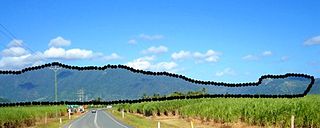
Australian Aboriginal religion and mythology is the sacred spirituality represented in the stories performed by Aboriginal Australians within each of the language groups across Australia in their ceremonies. Aboriginal spirituality includes the Dreamtime, songlines, and Aboriginal oral literature.

Rockhampton is a city in the Rockhampton Region of Central Queensland, Australia. In the 2021 census, the population of Rockhampton was 79,293.

The Fitzroy River is a river in Central Queensland, Australia. Its catchment covers an area of 142,665 square kilometres (55,083 sq mi), making it the largest river catchment flowing to the eastern coast of Australia. It is also the largest river basin that discharges onto the Great Barrier Reef.

Torres Strait Islanders are the Indigenous Melanesian people of the Torres Strait Islands, which are part of the state of Queensland, Australia. Ethnically distinct from the Aboriginal peoples of the rest of Australia, they are often grouped with them as Indigenous Australians. Today there are many more Torres Strait Islander people living in mainland Australia than on the Islands.

Central Queensland is an imprecisely-defined geographical division of Queensland that centres on the eastern coast, around the Tropic of Capricorn. Its major regional centre is Rockhampton. The region extends from the Capricorn Coast west to the Central Highlands at Emerald, north to the Mackay Regional Council southern boundary, and south to Gladstone. The region is also known as Capricornia. It is one of Australia's main coal exporting regions.
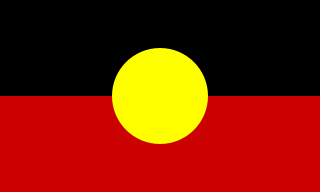
Aboriginal Australians are the various Indigenous peoples of the Australian mainland and many of its islands, but excluding the ethnically distinct people of the Torres Strait Islands. The term "Indigenous Australians" is applied to Aboriginal Australians and Torres Strait Islanders collectively.

Saibai Island, commonly called Saibai, is an island of the Torres Strait Islands archipelago, located in the Torres Strait of Queensland, Australia. The island is situated north of the Australian mainland and south of the island of New Guinea. The island is a locality within the Torres Strait Island Region local government area. The town of Saibai is located on the north-west coast of the island. According to the 2016 census, Saibai Island had a population of 465 people.

Hammond Island is an island with a town of the same name, in the Torres Strait, Queensland, Australia. It is the only island within the locality of Keriri Island within the local government area of Torres Strait Island Region.

Moa Island, also called Banks Island, is an island of the Torres Strait Islands archipelago that is located 40 kilometres (25 mi) north of Thursday Island in the Banks Channel of Torres Strait, Queensland, Australia. It is also a locality within the Torres Strait Island Region local government area. This island is the largest within the "Near Western" group. It has two towns, Kubin on the south-west coast and St Pauls on the east coast, which are connected by bitumen and a gravel road. In the 2016 census, Moa Island had a population of 448 people.

Stephen Island, called Ugar in the local Meriam language, lies in the eastern group of the Torres Strait Islands archipelago of Queensland, Australia. The island is within the locality of Ugar Island within the local government area of the Torres Strait Island Region.
Shane Pickett was one of the foremost Nyoongar artists. Combining his deep knowledge and concern for Nyoongar culture with a confident and individual style of gestural abstraction, Pickett created paintings that resonated with a profound but subtle immediacy. Balancing innovation with tradition, modernity with an ancient spirituality, Pickett created a complex visual metaphor for the persistence of Nyoongar culture against the colonising tide of modernity. During his career, Pickett was selected as a finalist in numerous major art prizes including the Telstra National Aboriginal and Torres Strait Islander Art Award, for which he won the 'Best Painting in a European Medium' category prize in 1986. In 2006 he was awarded first prizes at the Sunshine Coast Art Prize and the Joondalup Invitation Art Award, and in 2007 he was awarded the major prize at the inaugural Drawing Together Art Award. He has exhibited in every state and territory in Australia, as well as in the United States, Europe, Africa and Asia. His works are held in major private and public collections throughout Australia and internationally.
Indigenous Australians are people with familial heritage from, or membership in the ethnic groups that lived in areas within the Australian continent before British colonisation, or both. They consist of two distinct groups: the Aboriginal peoples of the Australian mainland and Tasmania, and the Torres Strait Islander peoples from the seas between Queensland and Papua New Guinea. The term Aboriginal and Torres Strait Islander peoples or the person's specific cultural group, is often preferred, though the terms First Nations of Australia, First Peoples of Australia and First Australians are also increasingly common; 812,728 people self-identified as being of Aboriginal and/or Torres Strait Islander origin in the 2021 Australian Census, representing 3.2% of the total population of Australia. Of these Indigenous Australians, 91.4% identified as Aboriginal; 4.2% identified as Torres Strait Islander; while 4.4% identified with both groups. Since 1995, the Australian Aboriginal flag and the Torres Strait Islander flag have been official flags of Australia.
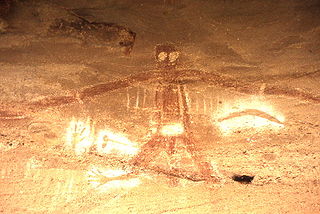
An Australian Aboriginal sacred site is a place deemed significant and meaningful by Aboriginal Australians based on their beliefs. It may include any feature in the landscape, and in coastal areas, these may lie underwater. The site's status is derived from an association with some aspect of social and cultural tradition, which is related to ancestral beings, collectively known as Dreamtime, who created both physical and social aspects of the world. The site may have its access restricted based on gender, clan or other Aboriginal grouping, or other factors.
The Darumbal people, also spelt Darambal and Dharumbal, are the Aboriginal Australian people who have traditionally occupied Central Queensland, speaking dialects of the Darumbal language. Darumbal people of the Keppel Islands and surrounding regions are sometimes also known as Woppaburra or Ganumi, and the terms are sometimes used interchangeably.
Bayali is an extinct Australian Aboriginal language of Queensland in Australia, spoken in the Rockhampton and Gladstone areas, but a project is under way to revive the language.
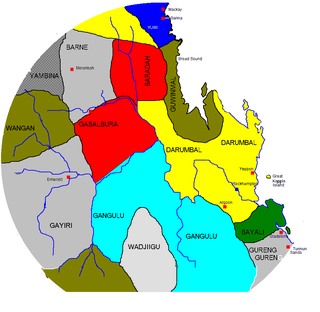
Darumbal, also spelt Dharambal, is an Australian Aboriginal language of Queensland in Australia declared extinct. It was spoken in the Rockhampton area of Queensland. Dialects were Guwinmal, Karunbara, Rakiwara, and Wapabura. It is classified with Bayali as a Kingkel language, but the two are not close, with a low 21% shared vocabulary. Indeed, Angela Terrill states that "there is no evidence on which to base a claim of a low-level genetic group including Dharumbal with any other language".
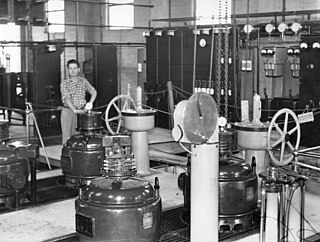
Yaamba is a rural town and locality in the Livingstone Shire, Queensland, Australia. In the 2016 census, the locality of Yaamba had a population of 62 people.
North Rockhampton is the common name for the suburbs of Rockhampton located on the north-east side of the Fitzroy River in Queensland, Australia.

Masig Island is an island and locality in the Torres Strait Island Region, Queensland, Australia. In the 2021 census, Masig Island had a population of 283 people.

The Rockhampton Heritage Village is a tourist attraction and multipurpose venue located in Rockhampton, Queensland, Australia.
















